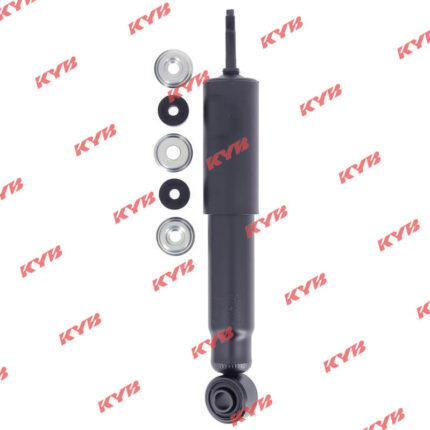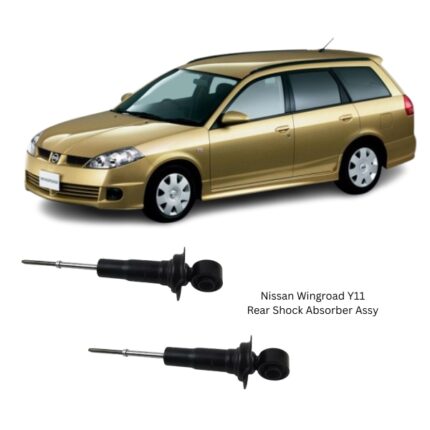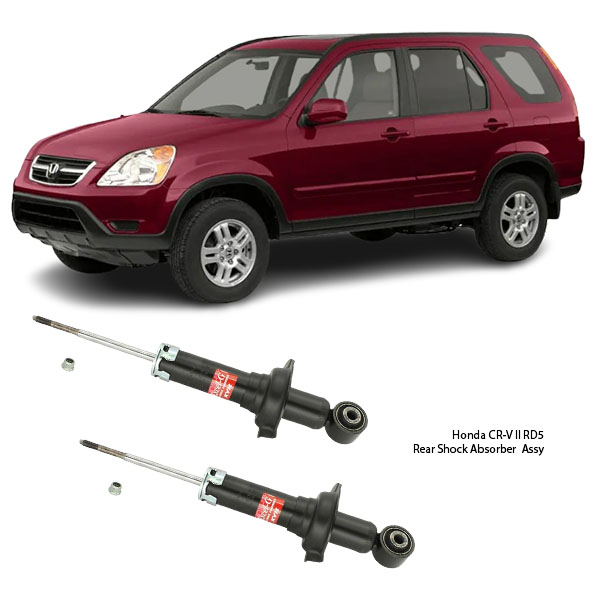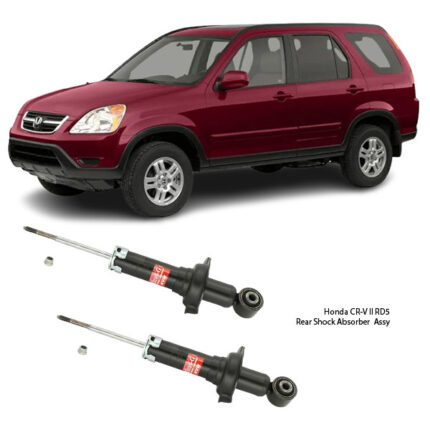Get Honda CR-V II RD5 Rear Shock Absorber Assy 341463 in Kenya
When it comes to vehicle comfort, handling, and safety, few components are as important yet often overlooked as the rear shock absorber assembly. Positioned at the rear axle of a car, van, SUV, or truck, this assembly plays a crucial role in absorbing road shocks and vibrations, ensuring the wheels maintain firm contact with the road surface.
This article offers a detailed look into what the rear shock absorber assembly is, how it works, the types available, when to replace it, and the benefits of using quality parts — especially for those in the automotive service and repair industry.
What is a Rear Shock Absorber Assembly?
The rear shock absorber assembly is part of the suspension system, designed to control the movement of the rear wheels and absorb energy from bumps, potholes, and road irregularities. Its primary function is to dampen the motion of the vehicle’s suspension springs and reduce the bouncing and swaying that occurs as the vehicle travels over uneven surfaces.
A typical rear shock absorber assembly includes:
-
The shock absorber (damper) – the main component that controls up-and-down motion.
-
Mounting bushings or brackets – to attach the shock securely to the vehicle’s chassis and axle.
-
Dust boots or covers – which protect the piston rod from dirt and debris.
-
In some vehicles, the assembly may include a coil spring (coilover setup) or form part of a rear strut assembly.
It is essential in stabilizing the vehicle’s rear end, especially during braking, turning, towing, or carrying heavy loads.
How Rear Shock Absorbers Work
Shock absorbers function by using hydraulic fluid and internal pistons to convert the kinetic energy of suspension movement into heat, which is then dissipated. When the vehicle hits a bump, the spring compresses, and the shock absorber controls the rate at which the spring expands and contracts.
Inside a shock absorber:
-
A piston moves up and down inside a sealed tube filled with oil (or sometimes gas).
-
As the piston moves, it forces the fluid through tiny valves or orifices.
-
This resistance to fluid flow creates a damping effect, slowing down suspension movement.
Without shocks, the vehicle would bounce uncontrollably after every bump, making it unsafe and uncomfortable to drive.
Why the Rear Shocks Matter
Rear shock absorbers have a significant impact on several critical vehicle functions:
-
Ride Comfort
They reduce road vibrations and prevent excessive body motion, providing a smoother experience for passengers — especially those in the rear seats. -
Vehicle Stability
They keep the tires firmly on the road, improving traction and control, particularly during braking and cornering. -
Brake Performance
When shocks are worn, the car may nosedive under braking, and stopping distances increase. Good rear shocks help distribute weight evenly during deceleration. -
Load Handling
In trucks and SUVs, especially those used for cargo or towing, quality rear shocks maintain balance and reduce rear-end sag when under load. -
Suspension System Longevity
By absorbing and controlling movement, shocks reduce stress on springs, control arms, bushings, and wheel bearings.
Types of Rear Shock Absorbers
There are several types of rear shock absorber assemblies depending on the suspension design:
1. Twin-Tube Shocks
-
Most common in everyday vehicles.
-
Includes an inner working tube and an outer reservoir tube.
-
Cost-effective and reliable for regular driving conditions.
2. Mono-Tube Shocks
-
More performance-oriented.
-
Contains a single tube with high-pressure gas and oil.
-
Better heat dissipation and response time.
3. Coilover Shocks
-
Combines the shock absorber with a coil spring.
-
Often found in performance or aftermarket suspension systems.
4. Strut Assemblies
-
In some cars, the rear suspension may use struts instead of shocks.
-
Struts support the vehicle’s weight and often integrate springs and mounts.
Each type must be chosen based on the vehicle make, model, usage conditions, and load demands.
Signs of a Failing Rear Shock Absorber Assembly
Shock absorbers wear out gradually, and drivers may not immediately notice the decline in performance. Here are the most common signs that replacement is needed:
-
Excessive bouncing or swaying after hitting a bump.
-
Uneven or scalloped tire wear, especially on rear tires.
-
Fluid leaks visible on the shock body.
-
Clunking or knocking noises from the rear suspension.
-
Longer braking distances or rear-end lift during braking.
-
Rear-end sagging or instability when carrying passengers or cargo.
If any of these symptoms are present, a qualified technician should inspect the shocks and recommend a replacement if necessary.
Rear Shock Absorber Replacement: What to Expect
Replacing rear shock absorbers is a straightforward process but should always be done in pairs (both left and right) to maintain balanced handling and braking. The basic steps include:
-
Lifting the vehicle and safely securing it.
-
Removing the rear wheels for access.
-
Unbolting the shock assembly from both the top and bottom mounting points.
-
Installing the new shock absorber, torqued to specification.
-
Reinstalling wheels and performing a road test.
Some vehicles may require alignment after shock replacement, especially if they use struts or coilovers.
Genuine vs. Aftermarket Rear Shocks
Choosing between OEM (genuine) and aftermarket shocks depends on your customer’s needs:
-
OEM Shocks
-
Designed specifically for the vehicle model.
-
Offers factory-fit, performance, and durability.
-
Ideal for vehicle owners who want original quality.
-
-
Aftermarket Shocks
-
Available in a wide range of options for comfort, performance, or heavy-duty use.
-
Brands like KYB, Monroe, Bilstein, and Sachs are well-known and reliable.
-
Often more affordable and easier to access.
-
At Onestop Garage & Auto Spares, we stock both genuine and high-performance aftermarket rear shock absorber assemblies — tailored to fit vehicles like Toyota Prado, Mitsubishi Pajero, Nissan X-Trail, and more.
Maintenance Tips for Longer Shock Life
-
Inspect shocks during every service (usually every 10,000–15,000 km).
-
Avoid overloading the rear axle, especially in small cars.
-
Replace worn suspension bushings to prevent stress on shocks.
-
Keep an eye on tire wear, which can hint at suspension issues.
Available at Onestop Garage & Auto Spares
Looking to replace your rear shock absorbers? At Onestop Garage & Auto Spares, we offer:
-
Wide range of rear shock absorber assemblies for Japanese, European, and German vehicles.
-
Quality options in both OEM and aftermarket.
-
Professional installation at our Nairobi garage on Baricho Road.
-
Countrywide delivery within Kenya.
-
Online booking and product inquiries via our website.
Whether you’re servicing a family sedan or a rugged 4×4, we’ll help you restore suspension performance with the right parts.
Conclusion
The rear shock absorber assembly may be hidden beneath the vehicle, but its job is vital to how your car rides, handles, and stays safe on the road. Regular inspection and timely replacement not only improve comfort but also preserve the integrity of the suspension system and other components.
If you’re in the market for reliable rear shocks, turn to a supplier that understands quality, fitment, and service — Onestop Garage & Auto Spares.
Follow us on Facebook for more parts.




